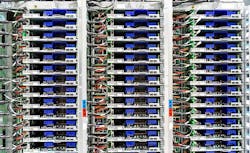Google is extending its infrastructure to the edge, bringing its cloud hardware and software into telecom networks and customer data centers, including on-premises facilities.
With its new Google Distributed Cloud offering, Google will provide managed cloud nodes that can reside in facilities operated by carriers, colocation providers, and customers. It features a portfolio of managed hardware and software that enable Google Cloud workloads wherever they are needed.
“Now more than ever, organizations are looking to accelerate their cloud adoption,” said Sachin Gupta, Google Cloud GM and VP of Product for IaaS. “Some workloads cannot move to the public cloud entirely or right away, due to factors such as industry or region-specific compliance and data sovereignty needs, low latency or local data-processing requirements, or because they need to run close to other services.”
The announcement ahead of today’s Google Next conference highlights the growing role of cloud platforms in the growth of edge computing. The new offering, along with the rollout of AWS Local Zones and Microsoft’s Azure Modular Data Center, further extends the reach of major cloud computing platforms in the edge computing sector.
Edge computing extends data processing and storage closer to the growing universe of devices and sensors at the edge of the network, enabling new technologies and services across low-latency wireless connectivity. Many startups and service providers are targeting edge computing, but cloud platforms play a central role in IT infrastructure, and their strategies will have huge impact on this emerging market.
For Google, the Distributed Cloud enables new ways to leverage partners like carriers and hosting companies to deliver services like 5G wireless, low-latency appplications and hybrid clouds.
The Distributed Cloud offering comes in two services:
- Distributed Cloud Edge, which can run in facilities operated by carriers, service providers, and customers, as well as 140 Google network edge locations around the world. Google expects its cloud services to help deploy low-latency applications at stores, offices, factories and content distribution sites.
- Distributed Cloud Hosted, a solution for global service providers that addresses data sovereignty, making it easier to use Google Cloud services while keeping data within local jurisdictions.
Google Distributed Cloud is built on Anthos, an open-source-based platform that unifies the management of infrastructure and applications across multiple data centers and public clouds.
Using Google Distributed Cloud, customers can migrate or modernize applications and process data locally with Google Cloud services, including databases, machine learning, data analytics and container management. Customers can also leverage third-party services from leading vendors in their own dedicated environment.
Google envisions four deployment scenarios for its Distributed Cloud Edge:
- Google’s network edge – Allowing customers to leverage over 140+ Google network edge locations around the world.
- Operator edge – Enabling customers to take advantage of an operator’s edge network and benefit from 5G/LTE services offered by leading communication service provider (CSP) partners. The operator edge is optimized to support low-latency use cases, running edge applications with stringent latency and bandwidth requirements.
- Customer edge – Supporting customer-owned edge or remote locations such as retail stores, factory floors, or branch offices, which require localized compute and processing directly in the edge locations.
- Customer data centers – Supporting customer-owned data centers and colocation facilities to address strict data security and privacy requirements, and to modernize on-premises deployments while meeting regulatory compliance.
Many of today’s Google Next announcements build on Google’s relationships with partners, like chipmakers Intel and NVIDIA, equipment vendors including Cisco, Dell, HPE, and NetApp, and telecom equipment specialist Ericsson.
“Google Distributed Cloud supports Ericsson’s vision of the network becoming a platform of innovation, enabling companies across the ecosystem to deliver the applications of the future the way they need to, unlocking the full potential of 5G and edge,” said Rishi Bhaskar, Vice President and Head of Hyperscale Cloud Providers for Ericsson North America.
Building Local Clouds for Data Sovereignty
Distributed Cloud Hosted is designed to address data sovereignty concerns, especially for customers in Europe, where the European Union’s GDPR privacy regulations are boosting demand for cloud technology that can keep workloads within national borders. Google can now team with local partners to provide compliant hosted solutions for public-sector customers and companies with strict data residency, security or privacy requirements.
Google Distributed Cloud Hosted does not require connectivity to Google Cloud at any time to manage infrastructure, services, APIs, or tooling, and uses a local control plane provided by Anthos for operations. The service will be available in preview in the first half of 2022.
Two of the first partnerships are with T-Systems in Germany and OVHcloud in France.
“T-Systems and Google Cloud share a common goal of developing cloud-based solutions for European governments and enterprises that meet their digital sovereignty, sustainability and economic objectives,” said Frank Strecker, Senior Vice President Global Cloud Computing & Big Data and Edge, T-Systems. “Together we will offer a sovereign cloud solution for customers in Germany that gives them peace of mind to meet their rapidly evolving data, operational, and software sovereignty requirements.”
About the Author



